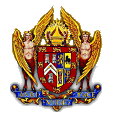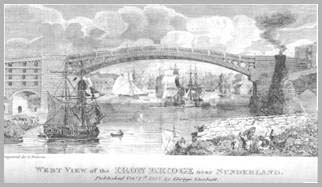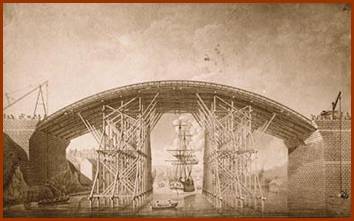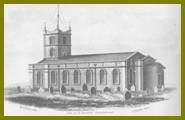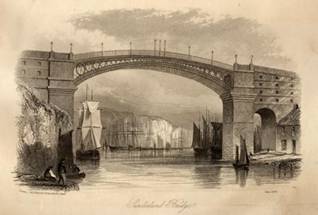
| | HOME | |
|
|
|
|
Why the Sunderland Iron Bridge
Michael Scarth who was the principal founder and First Principal of this Chapter of Strict Benevolence, No 97. Rowland Burdon, MP for Durham since 1790, who had previously built the turnpike road from Stockton to Sunderland (the A19), with the assistance of his Land Agent Michael Scarth, felt that he could combine the pressing need for north and south Sunderland to be joined by a bridge with his desire to extend his road northwards. He obtained the necessary Act of Parliament in1792 and the first proposal he considered was to build a stone bridge, but lack of suitable ground for foundations, busy river traffic and immense expense made him quickly abandon this proposal. Although cast iron had been used previously by Thomas Paine(Author of The Rights of Man etc.) at Ironbridge Rowland Burdon’s concept of using this new metal together with the ancient and well tried principle of stone arch construction, produced a much lighter, stronger and cheaper bridge in a much shorter time. This together with Thomas Wilson’s easily erected and dismantled scaffolding still allowed river traffic to operate as can be seen in Fig.2
After the Town of Sunderland and the County of Durham had given their approval to the project the foundation stone was laid on 24th September 1793. At Phoenix Hall, on that day, William Henry Lambton opened a Grand Lodge, (Provincial Grand Master 1787 – 1797) together with about 200 masons all clothed in appropriate Masonic dress. After these proceedings were completed their procession was met at the lodge gates by the magistrates, commissioners and other dignitaries and they all set off through a great throng of excited onlookers to the Sunderland Parish Church. The masons formed into two lines and the magistrates and other dignitaries entered and took their reserved seats in the church whilst the masons occupied the gallery.
The service being concluded the procession then moved through large crowds to the south side riverbanks. They then made their way, via a platform fixed to keels forming a wooden bridge across the River Wear, to the North West side of the planned IRON BRIDGE, where the first stone was to be laid. Rowland Burdon addressed the assembled gathering from a railed off portion on the cliff top informing them that he had been filled with confidence to undertake this vast project by that Great Power to whose protection he submitted its progress and completion. The stone was then laid by Rowland Burdon (acting as Provincial Grand Master for the day) assisted by the Provincial Grand Master and other Grand Officers according to ancient custom with a plate being inserted containing an inscription written in Latin by Dr Tipping Brown of Phoenix Lodge. After the stone laying ceremony was completed under the steep cliffs of the Wear the assembled thousands cheered and waved and the air was split with the sounds of bands and the firing of cannon from the vast number of vessels lying nearby. The procession returned to the Sea Captain’s Lodge where ceremonials were completed and they then retired to Phoenix Hall where ample provisions were provided for more than 200 persons to round off a most wonderful occasion. Michael Scarth made all of the arrangements necessary for this unique and historic day!! Bridge Construction Facts Some facts relating to the construction of the Bridge are set out immediately below
The fine detail of the brick work and iron work can be clearly seen as well as the iron balustrade, in the centre of which, on each side of the bridge, is an inscription fittingly proclaiming Sunderland City’s Motto:- NIL DESPERANDUM AUSPICE DEO |
Approved by the United Grand Lodge of England | Legal Notice
